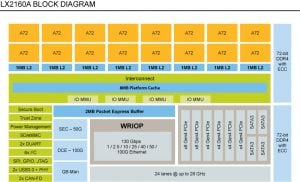 If you’ve ever broken an arm or a leg, you know what it means to have
an itch that you can’t scratch. Your doctor put your injured limb in a
cast, limiting its mobility and rendering it inaccessible to comforting
fingertips. At NXP, we have customers that feel the same way. They want many
high-performance CPUs, 100Gbps networking and modern I/O but are constrained
by cost, power consumption and form factor. A server-derived processor
solution might have the right performance but not fit within these
constraints. A multicore communication processor might have the requisite
power and integration but not enough general-purpose processing horsepower or
the right software ecosystem.
If you’ve ever broken an arm or a leg, you know what it means to have
an itch that you can’t scratch. Your doctor put your injured limb in a
cast, limiting its mobility and rendering it inaccessible to comforting
fingertips. At NXP, we have customers that feel the same way. They want many
high-performance CPUs, 100Gbps networking and modern I/O but are constrained
by cost, power consumption and form factor. A server-derived processor
solution might have the right performance but not fit within these
constraints. A multicore communication processor might have the requisite
power and integration but not enough general-purpose processing horsepower or
the right software ecosystem.
They can now scratch that itch. NXP just unveiled the QorIQ Layerscape
LX2160A
system on-chip. We have taken the winning combination of 64-bit Arm CPUs,
Ethernet and PCI interfaces and network accelerators found in other
Layerscape processors and scaled up everything. The LX2160A, for example, has
twice as many Arm® CPUs as its LS2088A stablemate and nearly twice the
IPSec performance of the 24-thread QorIQ T4240 processor. Best of all, the
LX2160A processor will not cost an arm or leg—power consumption and
price will be comparable to other QorIQ solutions.
 The CPUs are Arm’s powerful Cortex-A72 cores running at up to 2.2GHz.
NXP has found that, in standard benchmarks, these CPUs are as fast as a single
thread of a competitors’ server-derived processor and leave the wimpy
cores in other competitors many-core designs in the dust. To scale
performance, the LX2160A instantiates 16 of these cores. Helping to keep down
the cost of the memory hierarchy, the LX2160A integrates 16MB of cache and has
only two DRAM controllers. NXP selected this cache size based on analysis of
packet-storage requirements of networking workloads.
The CPUs are Arm’s powerful Cortex-A72 cores running at up to 2.2GHz.
NXP has found that, in standard benchmarks, these CPUs are as fast as a single
thread of a competitors’ server-derived processor and leave the wimpy
cores in other competitors many-core designs in the dust. To scale
performance, the LX2160A instantiates 16 of these cores. Helping to keep down
the cost of the memory hierarchy, the LX2160A integrates 16MB of cache and has
only two DRAM controllers. NXP selected this cache size based on analysis of
packet-storage requirements of networking workloads.
Being a multicore communication processor, data-plane performance is
paramount. The LX2160A SoC integrates a 130Gbps Layer 2 switch, 100Gbps of
compression acceleration and 50Gbps of crypto acceleration. To align with
cloud service providers and OEMs developing the next generation of equipment,
NXP made sure the LX2160A supports the newest Ethernet interface speeds:
100Gbps, 50Gbps, 25Gbps, and 2.5Gbps in addition to legacy 40Gbps, 10Gbps and
1Gbps rates. The PCIe ports are also up to date, supporting Gen 4 of the
standard (16Gbps per lane) and ports as wide as x8.
The LX2160A SoC is birthed into a rich ecosystem that includes standard
distributions like Ubuntu and Debian. After all, there’s no point to
giving system designers a processor with top-notch performance without also
giving them a top-notch ecosystem. NXP is at the forefront of applying to
embedded software development the community-style methods for building and
updating open-source software popularized in the computing domain. System
designers can now install application binaries from standard distros, easily
integrate individual components of NXP’s
SDK
into their own distribution and find NXP’s components within community
distributions because of the company’s effort to upstream software.
NXP also supports standard APIs for virtualization and NFV, including DPDK to
accelerate network functions, OVS for virtual switching and Virtio for
virtualizing device drivers. The LX2160A additionally will be capable of
running major SDN, NFV and virtualization open-source software including Open
Daylight, OpenStack and OP-NFV. NXP Arm processors incorporate hardware for
virtualization technologies such as KVM, Linux containers and NFV and SDN. We
foresee NFV, other virtualization applications and edge computing to be the
major adoption drivers of the LX2160A, especially because existing
applications built to run on smaller Layerscape devices can be easily brought
over to the LX2160A platform. Whereas those devices are mostly found in
customer premise equipment, the LX2160A will find homes in beefier edge
computing nodes, such as high-end enterprise routers, central offices, storage
infrastructure and base stations.
In conclusion, the Layerscape LX2160A processor is an excellent choice for
hosting networking workloads, including NFV, and other edge computing
applications, owing to the SoC’s 16 Arm cores, large caches, up-to-date
interfaces and 100Gbps networking. Moreover, a rich software ecosystem
complements the processor and includes standard Linux distributions and
software for SDN and NFV. The processor is also a smooth upgrade path for any
embedded-processor customer seeking greater CPU performance, 100Gbps
networking, 25Gbps/100Gbps Ethernet and PCIe Gen4. For more information,
please
Contact Us.


 If you’ve ever broken an arm or a leg, you know what it means to have
an itch that you can’t scratch. Your doctor put your injured limb in a
cast, limiting its mobility and rendering it inaccessible to comforting
fingertips. At NXP, we have customers that feel the same way. They want many
high-performance CPUs, 100Gbps networking and modern I/O but are constrained
by cost, power consumption and form factor. A server-derived processor
solution might have the right performance but not fit within these
constraints. A multicore communication processor might have the requisite
power and integration but not enough general-purpose processing horsepower or
the right software ecosystem.
If you’ve ever broken an arm or a leg, you know what it means to have
an itch that you can’t scratch. Your doctor put your injured limb in a
cast, limiting its mobility and rendering it inaccessible to comforting
fingertips. At NXP, we have customers that feel the same way. They want many
high-performance CPUs, 100Gbps networking and modern I/O but are constrained
by cost, power consumption and form factor. A server-derived processor
solution might have the right performance but not fit within these
constraints. A multicore communication processor might have the requisite
power and integration but not enough general-purpose processing horsepower or
the right software ecosystem.
 The CPUs are Arm’s powerful Cortex-A72 cores running at up to 2.2GHz.
NXP has found that, in standard benchmarks, these CPUs are as fast as a single
thread of a competitors’ server-derived processor and leave the wimpy
cores in other competitors many-core designs in the dust. To scale
performance, the LX2160A instantiates 16 of these cores. Helping to keep down
the cost of the memory hierarchy, the LX2160A integrates 16MB of cache and has
only two DRAM controllers. NXP selected this cache size based on analysis of
packet-storage requirements of networking workloads.
The CPUs are Arm’s powerful Cortex-A72 cores running at up to 2.2GHz.
NXP has found that, in standard benchmarks, these CPUs are as fast as a single
thread of a competitors’ server-derived processor and leave the wimpy
cores in other competitors many-core designs in the dust. To scale
performance, the LX2160A instantiates 16 of these cores. Helping to keep down
the cost of the memory hierarchy, the LX2160A integrates 16MB of cache and has
only two DRAM controllers. NXP selected this cache size based on analysis of
packet-storage requirements of networking workloads.


